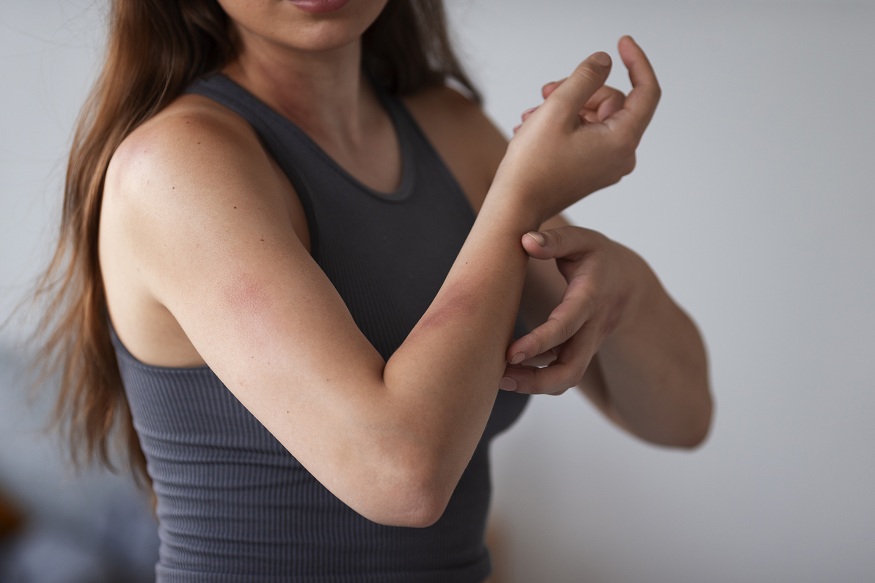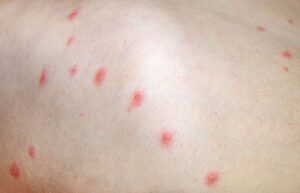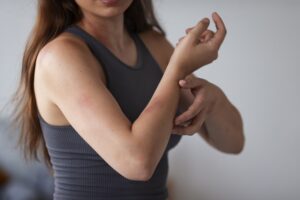
Just like malaria and chikungunya, dengue is also one of the mosquito-borne diseases. This usually affects people who live in tropical and subtropical regions of the world. The common symptoms of this condition are joint pain, fever, and headaches. But many people don’t know that dengue also causes skin issues, like rashes and itching in the early or later stages.
The skin itching that occurs because of the dengue disease usually causes minor irritation, but sometimes causes major discomfort. It might sound unserious, but it can extremely interfere with one’s sleep and disrupt their quality of life. Hence, in this blog, let us learn why dengue rash itching happens and how it can be addressed.
What is Dengue?
Dengue, like all the mosquito-borne diseases, is also transmitted from or by the bite of an infected female mosquito referred to as Aedes aegypti. These mosquitoes have black and white stripes, giving them the name tiger mosquitoes.
Dengue might not be a contagious disease, but it can be transmitted through subsequent bites. In areas where sanitation is poor, water is stagnant, and the mosquito densities are higher, dengue spreads more quickly.
What Are the Common Symptoms of Dengue?
The symptoms of dengue usually start from the 4th day after the mosquito bite and last for over a week. The most notable signs are:
- A severe or sudden fever sometimes crosses 104 degrees.
- Severe headaches or pain behind the eyes.
- Muscle and joint pain, sometimes referred to as breakbone fever.
- Weakness and fatigue.
- Vomiting and nausea.
- Skin rashes usually appear after the fever has reduced.
- Mild bleeding from the gums or nose in some cases.
With enough hydration and rest, most patients recover thoroughly, while some might face serious complications. Having symptoms such as stomach pain, bleeding, persistent vomiting, or breathing difficulty, and other dengue rash symptoms, medical intervention is a must.
What Are the Causes of Skin Rash and Itching in Dengue?
Itching and rashes are the general skin problems in dengue, and they occur during the later stages or recovery period of the condition. These occur due to various reasons.
1) Capillary Leakage: The virus damages small blood vessels in the skin and causes leakage.
2) Immune Response to the Virus: The virus stimulates the immune system of the body, making it release chemicals that expand the blood vessels and cause inflammation, leading to skin rashes and itching.
3) Skin Dryness During Recovery: The skin becomes dry and starts to peel like a sunburn during the recovery period. This causes maximum itching in the legs, trunk, and arms.
4) Platelet Drop: The loss of platelets is also another indicator of dengue. When it drops, little red or purple drops might be visible on the skin, leading to itching and discomfort.
5) Hypersensitivity Reactions: Some people have excessive and faster immune responses, though the virus has decreased. Although the fever has subsided, skin itching and rashes will occur in the later stages of the condition.
How Can Skin Problems in Dengue Be Treated?
The primary focus of the dengue treatment is to alleviate the symptoms and aid the body’s recovery. Skin issues can be resolved promptly with simple lifestyle adjustments and timely medical advice.
1. Drinking Plenty of Water
Frequent hydration is a must when you have dengue. Drinking a lot of water keeps your skin hydrated, releases toxins from the body, and mitigates itching and dryness. Routine oral hydration, consuming soups, and fresh juices, are highly beneficial.
2. Seek Medical Advice
It is wise to seek professional advice from the top general medicine hospital in Coimbatore if the symptoms, especially itching, get worse. A doctor can evaluate the disease, rule out complications, and offer customized guidance for smoother relief.
3 . Applying Mild Skin Soothers
Aloe vera gel, cucumber slices, and moisturizers soothe rashes and prevent them from worsening.
4. Avoid Scratching
Scratching usually gives temporary relief from the pain, but it can lead to irritation and other infections. Keeping clean fingernails and wearing loose cotton dresses helps to prevent the urge to scratch.
5. Gentle Bathing Practices
To maintain your skin’s health, use fragrance-free, gentle soaps while bathing. Using chemical products and hot showers can irritate your skin and cause dryness.
6. Switch to a Skin-Friendly Diet
Antioxidants, protein, and vitamin C-rich foods improve immunity and repair skin. Eggs and lentils are the highest source of protein that helps with the skin repair process.
Using a Cold Compresser
Apply a cold, damp cloth to the affected area of the skin to ease the irritation. So that the itching will subside and the inflammation will reduce.
Conclusion
Skin rashes and itching are the most frequently overlooked symptoms of dengue. Skin conditions in dengue mainly occur in the recovery phase. That is when the skin dryness, platelet changes, and immune reactions happen. These might not be the major complications of dengue, but they can impact the quality of sleep.
With a balanced diet, proper hydration, prompt dengue treatment in Coimbatore, and natural skincare, itching and rashes can be easily managed. Always consult a doctor if you or your loved ones have these skin conditions while recovering from dengue.








